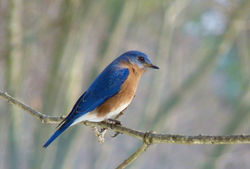Shenandoah Audubon/Blandy Bluebird Trail
The Shenandoah Audubon/Blandy Bluebird Trail (SA/BBT) lies within the 700-acre, low rolling hills of the State Arboretum of Virginia, home to the University of Virginia’s historic Blandy Experimental Farm and field research station. This trail project provides habitat for the Eastern Bluebird, Sialia sialis (EABL), and other cavity nesting birds including the Tree Swallow, Tachycineta bicolor (TRES); House Wren, Troglodytes aedon (HOWR); and Carolina Chickadee, Poecile carolinensis (CACH).
As the trail increases available nesting habitat, it also supports wider education and research efforts. Individuals and families interested in getting hands-on with nature are invited to participate in field-related citizen science as trail technicians. Through this role, community members can supports wider bird research by collecting accurate and precise data along the trail. If you are interested hands-on nature exploration, this is an opportunity for you! Learn more below.
For more information about the trail project or to get involved, please contact SA/BBT Trail Manager Kaycee Lichliter at kayceelichliter@hotmail.com.
 |  |  |  |  |  |  |  |
|---|
Contact Us
The Shenandoah Audubon/Blandy Bluebird Trail is located at the Blandy Experimental Farm and field research station (latitude 39.078N, longitude 078.050W), between US Route 50 and State Route 628 in Clarke County, Virginia.
The grounds serve many interests; besides the arboretum and research facility, the property is open to the public 365 days a year and is utilized for special events, environmental education, scientific research, passive outdoor recreation and a bridle trail. The SA/BBT is funded by Shenandoah Audubon and private donations and is operated solely by volunteers. The current trail system totals 132 nest boxes and is divided into eight sub-trails: Tuleyries, Kestrel Knob, Above Lake Arnold, Back 20, Ginkgo, Quarters, Wrenville, and Catbird Branch.
Research
Data gathered from The Shenandoah Audubon/Blandy Bluebird Trail project is submitted annually to The Virginia Bluebird Society, The Cornell Lab of Ornithology’s Citizen Science NestWatch Program and Blandy Experimental Farm. The trail has participated in research projects involving The US Geological Survey, The Patuxent Wildlife Research Center, The Bird Banding Laboratory, Laurel, Maryland, The Smithsonian Migratory Center for Birds. Two specific studies were; The Cornell Lab of Ornithology Incubation Rhythm Study and the North Carolina Museum of Natural Sciences Sparrow Swap Project.
The Shenandoah Audubon/Blandy Bluebird Trail project has been highlighted in many publications to include, but not limited to:
Science Magazine, 3 June 2005, Vol. 308 No. 5727
Virginia Wildlife, May 2009
Inside the Birdhouse/Cornell Lab of Ornithology, Issue 12, Spring 2006
Oak Leaf, Shenandoah Audubon Newsletter, Vol. 38, Issue 1, March-April 2014
The Northern Virginia Daily
The Winchester Star
Trail manager, Ms. Kaycee Lichliter, was highlighted in the textbook:
Ornithology, Foundation, Analysis, and Application, edited Morrison, Michael L., editor, © 2018 Johns Hopkins University Press, pg. 927
Trail Reports:
Trail Technicians
Responsibilities
As a trail technician, you will...do what? Actual role and general responsibilities are not listed.
Who can get involved?
New trail technicians will receive training during two workshops, totaling approximately five (5) classroom hours. These Workshops will cover... Returning trail technicians are required to attend at least one training workshop at the beginning of each season, equaling approximately two (2) classroom hours annually.
Trail technicians should conduct themselves in a professional manner at all times while striving to follow the guidelines set forth in the current protocol manual and to abide by all rules, regulations and policies of the Arboretum while on University of Virginia Blandy Farm premises, including not driving vehicles through fields or research areas without prior authorization. Does the manual include all rules/regulations/policies? It seems like this belongs in information covered during training or on a page for people who have already been trained rather than on a page for people interested in becoming trail technicians.
After workshop completion, in order to be scheduled for trail duties, each trained trail technician must submit a signed and dated Volunteer Registration Form valid for one monitoring season on which they may indicate scheduling preferences and planned vacation dates. Trail managers will work diligently to schedule technicians accordingly. If a trail technician is unable to monitor as scheduled, he or she must arrange for a substitute trail technician to cover their duties and report any planned changes to the trail manager or other appointed individual immediately. Trail technicians will receive a list of project participants from whom they can elicit coverage; this list is not to be shared outside of the project for reasons of confidentiality. Trail technicians are not permitted to manipulate the nest boxes outside of specifically scheduled monitoring times.
Trail technicians are encouraged to share their knowledge and experiences and are welcome to invite others from the general public to join them while performing assigned duties; however, the trail technician is solely responsible for all actions of those accompanying them. Only trail technicians are permitted to manipulate the nest boxes, and, as complete, accurate and systematic order of data collection is vital to the project, only trail technicians are permitted to record data in the trail books; others may help carry equipment, take photos, etc.
Trail Manager
The trail manager obtains trail sponsorship and funding; recruits, trains, and manages volunteers; develops protocol and worksheets; coordinates and/or performs trail maintenance, weekly trail book review, and follow up; and compiles and submits data and reports. The trail manager, in accordance with participant availability, skills, and interests, may delegate duties as deemed necessary in order to achieve the purposes and objectives of the project.
The Shenandoah Audubon/Blandy Bluebird Trail Manager is Kaycee Lichliter. For more information about the trail project or if interested in participating, please contact Kaycee at kayceelichliter@hotmail.com.
